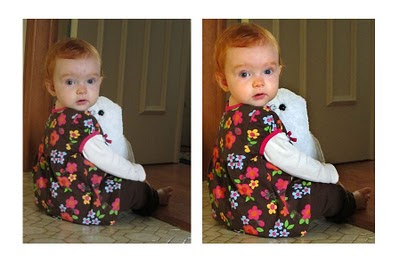I like to 'print' all my images. I very rarely just accept an image as it comes from my camera. When I noticed Fiona sitting on the floor hugging her fluffy, white seal, I grabbed my Canon S90 and set it to the low light level setting for dim lighting.
On this setting, the camera automatically treats two adjacent pixels on the sensor as one and as result the file size of the images drops from 10MB to 5MB. On the plus side, the image noise is not as high as one would expect when shooting at ISO 3200. The camera picked a shutter speed of 1/30 second and set the lens to f/4.9.
 |
| Image straight from camera on left; image after Photoshop on right. (Click to enlarge.) |
I took the best image into Photoshop where I cropped it and straightened it by rotating the crop box. Next, I corrected the colour by clicking on the brightest area of Fiona's white sleeve. I determined the specific spot by going into Levels (Control-L) and while pressing the Alt key, Option on a Mac, I slid the white triangle at the right-bottom of the histogram until the black screen had a bright white speck. That white speck was the brightest white in the image. I returned the white triangle to its starting point and clicked the white area with the white eyedropper.
I then set the endpoints for the picture in Photoshop. I held the Alt key and moved the white triangle and then the black triangle. In this way, I controlled the whites that were blown and the blacks that were plugged. I find it best to blow as few whites as possible --- I try to stick to spectral highlights --- and to be a wee bit generous in the plugging of blacks. This ups the overall contrast of the image, giving it more punch.
Then, I selected Fiona's face and tweaked the endpoints of the selection using Levels and I tweaked the skin tone by going into Curves and removing a little yellow.
My last step was to resize the image for the web (7-inches deep at 72 dpi) and give it a whack of USM (Unsharp mask: Amount 160% / Radius 0.4 pixels / Threshold 3 Levels).
Was I totally happy with my Canon S90 results? No. The shutter speed the camera picked was awfully slow and this made capturing movement difficult. I could have done better with a DSLR and a very fast lens --- f/2.8 or faster.
On the other hand the S90 is always handy because of its small size and the images it does capture are quite good. I may not be totally happy with my little point-and-shoot but I still totally love it.









